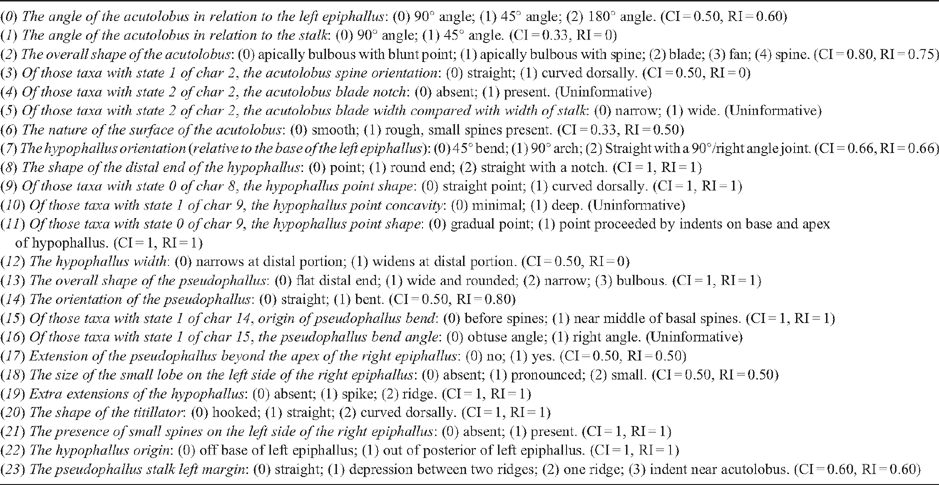Phylogeny and evolution of male genitalia within the praying mantis genus Tenodera (Mantodea : Mantidae)
Dana Jensen A C , Gavin J. Svenson A B , Hojun Song A and Michael F. Whiting AA Department of Biology, Brigham Young University, Provo, Utah, USA.
B New York State Museum, Albany, New York, USA.
C Corresponding author. Email: djensena@gmail.com
Invertebrate Systematics 23(5) 409-421 https://doi.org/10.1071/IS09004
Submitted: 21 January 2009 Accepted: 16 October 2009 Published: 16 December 2009
Abstract
The mantis genus Tenodera is composed of several species distributed across Africa, Asia and Australasia, along with recent human introductions to North America. Species of the genus are morphologically similar and utilise equivalent habitats across their distribution. Relationships among these species and the morphological characters used to diagnose them have never been formally tested, leaving authors to disagree as to the species composition of Tenodera. With DNA sequence data from five molecular loci and morphological characters from male genitalia, we reconstructed the phylogeny of Tenodera using multiple optimality criteria. All included species were found to be monophyletic in analyses of the combined data. Tenodera sinensis and T. bokiana were both supported as distinct species recovered in separate clades, resolving confusion as to their placement and classification. Our analysis identified a previously undescribed species of Tenodera collected in India, recovered as sister to T. aridifolia and T. sinensis, and exhibiting distinct male genital morphology. In light of the phylogeny, we characterise for the first time, and investigate the evolution of, the male genitalia, which allowed us to discover several transitions in structural forms. We also consider the connection of these transitions to sexual cannibalism and how this behaviour may have led to rapid evolution of the male genitalia.
Additional keywords: cannibalism, Chinese mantis, genital morphology.
Acknowledgements
We wish to thank our many in-country collaborators, educational institutions, museums, and the governing bodies of the countries listed below. Listed by country are those we wish to specially acknowledge for their participation, professionalism, and significant contributions to the success of this research: Independent State of Papua New Guinea – Andrew Mack; The National Research Institute; The Government of the Independent State of Papua New Guinea, Department of Environment and Conservation- Permit No. 12000061154, Export permit No. 200306/7 (2000), No. 010208 (2001); Republic of India – Prof. Hemant V. Ghate and Modern College; Prof. Aparna Dutta Gupta and the University of Hyderabad; R. Michael Buam, Nilesh Rane, Anand Padhye, Damodara Rao Guillipolii; Prof. Besterwell Kharbuli and the North Eastern Hill University; Prof. R. K. Bhola and Gauhati University; The Office of the Prl. Chief Conservator of Forests, Government of Andhra Pradesh Forest Department Rc.No.35869/2002/WL-3; S. E. Rizwi, Section Officer and the Ministry of Human Resource Development, Department of Secondary and Higher Education R. P. Permit No. 635/02 U-4, Visa # M 787100. Malaysia – Julie Urban, Jason Cryan, Catherine Yule; Brian Clark and Gunung Mulu National Park; Mr. Kamil and Lambir Hills National Park; Fatimah Abang and the University of Malaysia Sarawak; Haji Ali Bin Yusop and Sarawak Forests Department; Lucy Chong, Sarawak Forestry Corporation; Ludi Apin and Crocker Range National Park; Jamili Nais and Sabah Parks; Government of Malaysia, the State Government of Sarawak, and the State Government of Sabah; Economic Planning Unit of Malaysia, UPE: 40/200/19 SJ.1040 (permit ID # 1389), 40/200/19/1481 (permit ID # 1933). Republic of South Africa – Stephen L. Cameron, Hendrik Sithole, Thembi Khoza, Samuel Nkuna, Scientific Services, Kruger Range National Park; Government of the Republic of South Africa. Republic of Zambia – Jason Cryan, Timothy McCabe, Fabian Malaya, Keddy Mbindo, Keddy McKenzie; Lishomwa Mulongwe and Zambia Forestry; Anna Chileshe, Director of Forestry, Forestry Department, Ministry of Environment and Natural Resources. Commonwealth of Australia – Stephen L. Cameron; Parks and Wildlife Commission, Northern Territory, Permit No. 14353, Litchfield National Park, Gregory National Park; Department of Conservation and Land Management, Western Australia, Drysdale River National Park, Permit No. SF003947. This research was funded by Brigham Young University, David M. Kennedy Center for International Studies, and the National Science Foundation grants DEB-9983195 and DEB-0120718 to MFW.
Arnqvist G.
(1998) Comparative evidence for the evolution of genitalia by sexual selection. Nature 393, 784–786.
| Crossref | GoogleScholarGoogle Scholar |
CAS |
[Verified November 2009]
Holwell G. I.
(2008) Geographic variation in genital morphology of Ciulfina praying mantids. Journal of Zoology 276, 108–114.
| Crossref | GoogleScholarGoogle Scholar |
[Verified November 2009]
Kaltenbach A. P.
(1996) Records for a monograph on Mantodea of Southern Africa: 1. Species inventory, geographical distribution, and distribution limits (Insecta: Mantodea). Annalen des Naturhistorischen Museums in Wien Serie B Botanik und Zoologie 98, 193–346.
[Verified November 2009]
Nixon K. C., Wheeler Q. D.
(1990) An amplification of the phylogenetic species concept. Cladistics 6, 211–223.
| Crossref | GoogleScholarGoogle Scholar |
[Accessed November 2009]
Ronquist F., Huelsenbeck J. P.
(2003) MrBayes 3: Bayesian phylogenetic inference under mixed models. Bioinformatics 19, 1572–1574.
| Crossref | GoogleScholarGoogle Scholar |
CAS |
PubMed |
[Verified November 2009]
Svenson G. J., Whiting M. F.
(2004) Phylogeny of Mantodea based on molecular data: evolution of a charismatic predator. Systematic Entomology 29, 359–370.
| Crossref | GoogleScholarGoogle Scholar |
(see also Fig. 5)


|


